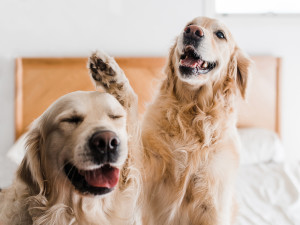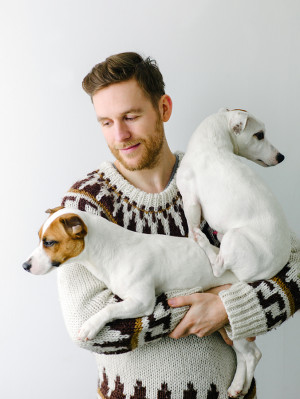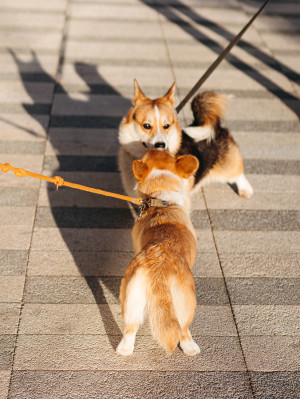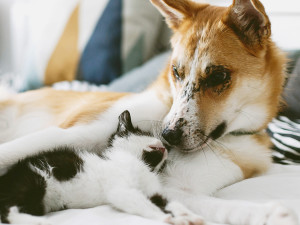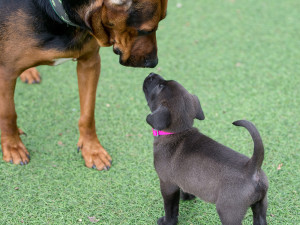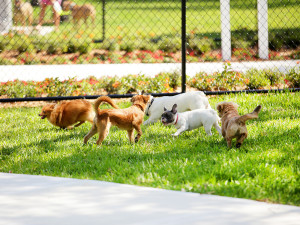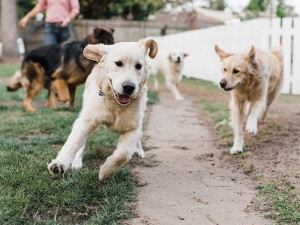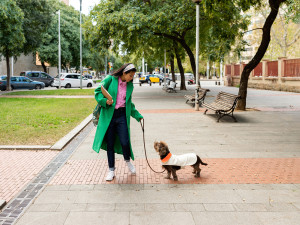How to Properly Introduce Two Pups
There’s a lot more to it than sniffing each other’s butts.
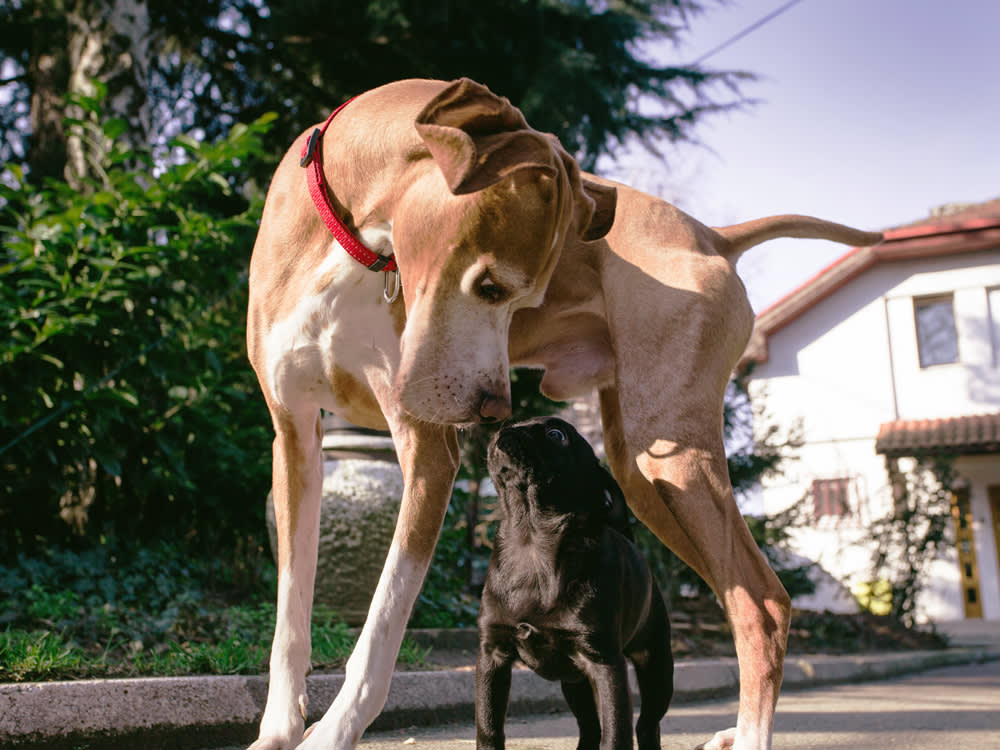
Share Article
Whether you’ve had a dog for years or recently brought home a new puppy, chances are your dog encounters other dogs pretty frequently. While we humans may greet each other with a head nod or hello, dogs have a far more complex way of greeting one another.
What are dog greetings, exactly? Dogs are intensely social creatures, and while it’s not possible to say what canine greetings are actually for — they have not been studied enough — it’s likely that they serve more than a single purpose. Greetings between dogs serve a lot of functions, from reducing uncertainty, fear, and arousal to gathering information. They can be used to signal status, increase tolerance for being in close proximity to one another, and aid with conflict resolution and reconciliation.
The function of greetings between dogs who are familiar with one another and those who have never met are likely not the same. Between unfamiliar dogs, the goal of a dog-to-dog introduction is probably to assess one another: Are you a male or a female? Intact or altered? Where have you been? How old are you? Do you like to play? Are you friendly? Sociable? Well-mannered? Are you someone I want to interact with? On the other hand, dogs who know each other well have less to learn, which means their greetings are more likely about continuing the relationship and expressing emotions about the reunion.
What do appropriate dog greetings look like?
Despite some variations, the basics tend to be the same. Dogs move toward each other in a calm and relaxed way, often approaching from the side or along an arc rather than head-on. Sniffing is a huge part of the process, and dogs may take an interest in any area with glands, pheromones or other scents. They might touch noses first, then move on to sniff the anogenital region, or they might start their investigation at the back end of the other dog. According to Dr. John Bradshaw, PhD, males typically sniff the area under the tail right away, while most females initially go for the head.

If the greeting is going well, the dogs’ bodies will be relaxed. Their tails might be moving and have a flexible look; their ears are not pulled back and their jaws will be relaxed as well. Both dogs should be visibly comfortable with the interaction rather than anxious or afraid.
It’s common for dogs to part ways after a short greeting. Dr. Camille Ward, PhD, studied greetings at a dog park (excluding the initial entries, which often involved a mob scene) amongst 52 dogs and found that they were surprisingly brief — typically six to eight seconds, with dogs going their separate ways after this fleeting interaction. The shortness of the greetings was not the only surprise in the study; Dr. Ward also found that only 12 percent of greetings progressed to play. This suggests that (a) when dogs are free to choose, they greet and move on quickly and (b) play is not nearly as likely an outcome of greetings as you might think.
Some dogs don’t engage in greeting behavior at all — and that’s okay. Dr. Ward, who saw no aggression during this study, found that more than 80 percent of the greetings were unreciprocated. (When dogs were of similar weight, it was more likely that the greeting would be reciprocal.) If your dog isn’t interested in greeting another dog, it’s best to honor their choice (rather than try to force them to say hello).
What do problematic dog greetings look like?
There are many signs that a greeting is not going well. A dog may make a beeline for, rush at, or jump on the other dog, which is not only bad manners but can also overwhelm or frighten the dog who’s being charged.
Signs that trouble is brewing include tension anywhere in a dog’s body, facial expressions indicating anxiety, fear or other negative emotions, and/or a tail that is slowly twitching at the tip or stiff or tucked under the body. If a dog lays their head or paw over the top of another dog’s shoulders, that is considered very pushy, making it an inappropriate greeting behavior. Intense staring, another definite no-no, is a behavior that goes beyond rude straight into threatening.
Yelping or other high-pitched vocalizations usually indicate that a dog is upset and not enjoying the interaction. Leaping up, muzzle punching, growling and, of course, biting fall far outside the bounds of acceptable greeting behavior. If one dog sniffs but refuses to let the other dog sniff back, tension may result, and that can lead to trouble.
While dog introductions can go awry because of canine social faux pas, humans sometimes inadvertently make things worse by: tensing up, holding our breath or displaying other signs of nervousness; standing still (which forces the dogs into a prolonged interaction), crowding the dogs, tightening up on the leash, insisting that the dogs work it out, speaking in harsh or anxious tones, or punishing the dogs.
Dogs are sensitive to your behavior and body language, so if you’re nearby when they are in a tense situation, what you do affects them. Do your best to alleviate the tension instead of adding to it. Stay calm and speak in happy, lighthearted tones, perhaps saying something simple like, “This way!” in an upbeat manner, and then moving away from the other dog. Keep walking if possible, and encourage your dog to move, too. Moving often disrupts the intensity of a greeting that is not going well because it allows the dogs to disengage from the interaction.
How do you introduce dogs properly?
Greetings are most likely to go well when dogs do not feel trapped, so if possible, introduce the dogs off-leash. When dogs are on-leash, the greeting is not on their terms because they are being forced to be close to each other and lack the freedom to move away. If having the dogs greet off-leash is not possible, the next best thing is to keep the leashes loose. Dropping the leashes is sometimes an option, too.
Ideally, dog meetings should take place in an open space rather than a confined area, which allows the dogs room to move and get away if they choose. Being outdoors also gives dogs the “pee-and-flee” option.
In a study of olfactory investigation and urination at a dog park, Dr. Anneke Lisberg, PhD, noticed a strong tendency of entering dogs to walk or run away from the dogs swarming them at the gate, and then urinate once they were at a distance. Often, the other dogs would investigate the urine, which gave the new dog some breathing room. Dr. Lisberg hypothesized that urinating gives dogs an opportunity to communicate with other dogs without continuing to be sniffed directly, thus breaking the tension that is so common when dogs who don’t know each other are greeting one another. When house trained dogs are forced to greet one another inside, they’re robbed of this valuable “pee-and-flee” strategy.
One of the best ways to ensure a proper dog greeting is to keep it short and sweet. Since dogs naturally engage in short greetings anyways, it makes sense to play by these canine rules.
What about dogs who already know each other?
Dogs who are old buddies may go right into play. This works if they are both comfortable with skipping the usual niceties. The problem is that dogs accustomed to this sort of interaction sometimes try the same thing with unfamiliar dogs, who may not respond well. The way dogs act with their best buddies may not be appropriate when meeting someone new. (The same goes for us humans, too!).
It’s incredible that simple hellos between dogs can be so complicated. But, given the huge amount of information exchanged during greetings and the potential for intense emotions, we should be more amazed than surprised.

Karen B. London, PhD, CAAB, CPDT-KA
Karen B. London is a certified applied animal behaviorist (CAAB) and certified professional dog trainer (CPDT) who specializes in working with dogs with serious behavioral issues, including aggression. She has written for a variety of magazines including The Bark, Clean Run, and the APDT Chronicle of the Dog, and has published in scientific journals including Behavioral Ecology and Sociobiology, Ethology, Ecology, and Evolution, the Journal of Insect Behavior, and Insectes Sociaux. She is the author of seven books about dog training and canine behavior, including the forthcoming My Dog's Mystery Adventure: And Other Stories From a Canine Behaviorist and Dog Trainer.
Related articles
![dog and cat snuggling together]()
Animal House: How to Intro a New Dog to Your Other Pets
...Without turning your home into a circus.
![Big dog meets little brown puppy for the first time]()
Getting a Second Dog?
Use these tips before making the big decision.
![A group of dogs running around in grass.]()
Create a Neighborhood Dog Park and Win Over All the Local Pups
The hottest club in your neighborhood is...the dog park.
![Four dogs running around in an enclosed outside area]()
Should You Send Your Pup to Dog Daycare?
Doggy daycare is more than just fun and games.
![Trendy woman in a green coat walking her cute dog in a white jacket in public]()
6 Reasons to Set Boundaries for Your Dog
Well-trained dogs have more freedom (and more fun).


